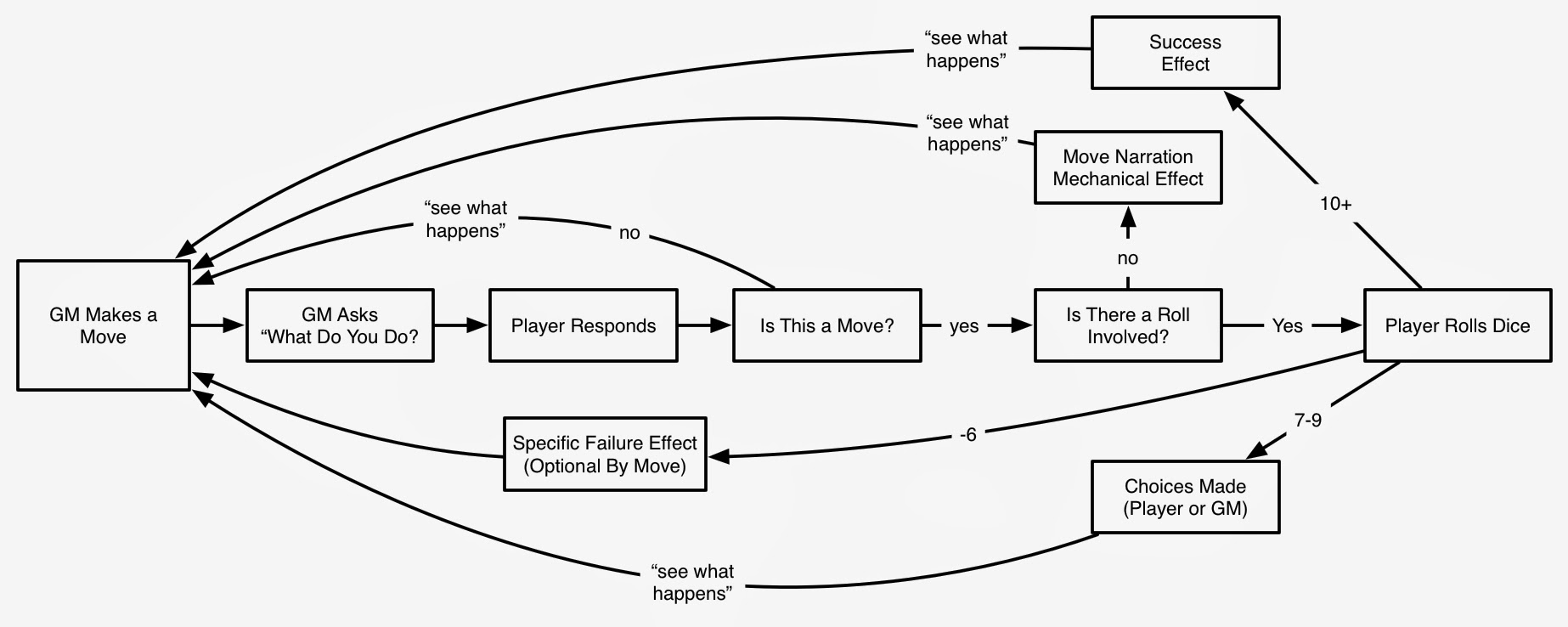
Because I am a sucker for a flowchart… inspired by +Kasper Brohus Allerslev’s chart; this is a first-try at a “Dungeon World flow-of-play” diagram.
Am I missing anything?
Because I am a sucker for a flowchart.

Because I am a sucker for a flowchart… inspired by +Kasper Brohus Allerslev’s chart; this is a first-try at a “Dungeon World flow-of-play” diagram.
Am I missing anything?
Comments are closed.
General fail result?
Looks good, although I think “Specific Failure Effect” is a bit vague for what is happening on a 6-. It is also the only line where there is no “See what happens”.
Giovanni Lanza a general fail result is a GM move.
Michael Walsh specific failure effect is generally only necessary when one is written into the move. Otherwise, a failure is just a GM move. you’re not “looking to the GM to see what happens” – they’re making a move. It’s the only other trigger for when a GM moves.
Hmm. Do you want to separate out soft and hard moves? probably not mechanistically like this.
Stras Acimovic yeah, this is all just “fiction triggers moves” stuff. The Principles and Agenda dictate whether you use hard or soft moves.
I dunno, it just seems odd that you have 10+ & 7-9 but not even an arrow with 6- leading to “GM makes a move”.
Giovanni Lanza look again, the line that leads from “player rolls dice” to “specific failure effect (optional)” has a little -6 on it.
/sub
Ah, good point!
I think a strong point of re-assessing this whole flow is that people underestimate how often the GM is making moves (it’s: always, over and over)
Ah, I see it now! I was looking on my phone’s tiny screen. Looks good!
Updated version here: https://twitter.com/skinnyghost/status/441720610062757890/photo/1
But Adam Koebel, I don’t see whining to the GM anywhere in the chart!
Marshall Miller see entry for “golden opportunities”
Technically speaking, you’ve put asking questions outside the “flow of play” with this, because stuff like “What was this place like when you lived here, Avon?” and “Who made your magic sword, Brunhilda?” aren’t moves.
Johnstone Metzger I added a “based on principles and agenda” note to the Gm Makes a Move box, though the asking isn’t a move, you’re right, it might need a “GM” sub-section that deals with prep and asking questions.
Sure. Probably everything that isn’t a move is either asking a question or describing stuff (like “have you been here before?” and “people here like to wear blue a lot”). But you also have occasional cases like the GM says “you arrive in Westmark after a few days” (is that even a move?) and a player goes “heyo, Port in a Storm!” before the “what do you do” can be asked. Once you get into an actual scene, though, after the framing and whatnot is all done, you pretty much just stick to the diagram as-is.
I think that this doesn’t tell you how to make choices about things like “when to make a hard or soft move” but clears up the whole “when does the GM get to go” thing. Or tries to.
This is cool.
Can you unpack ‘see what happens’ at little? Is it meant to include descriptions by the GM and players, questions and answers, and golden opportunities?
Oliver Granger “you’ll make moves when players miss their rolls, when the rules call for it, and whenever the players look to you to see what happens.”
So, basically, any time the players aren’t triggering a move, or the move is done triggering, the players look at the GM to see what happens. Stuff like;
“I spit in the Duke’s face…”
“I try to scale the wall with my bare hands.”
“I eat the mushrooms!”
“I sit perfectly still, hoping the T-Rex won’t see me.”
Yes, that’s true. Last time I wrote up an a/p/m list, I did separate lists for automatic moves (describe, ask), setup moves (ie soft), and hard moves. But the truth is, you sometimes use hard moves on a 7-9 (success with consequences, where consequences = a hard move). I can show you later.
The flow chart could also work if the “GM makes moves” was more central and the other boxes wrapped around it. Might make the play loops stand out more.
Hmm. Johnstone Metzger and Adam Koebel, you got me thinking… I know “ask the player” and “provide detail” aren’t moves in any AW-style game that I know of. But should they be moves?
(Maybe not “Ask the player” verbatim, but something like “Defer to the character’s history or expertise.”)
Well, I could show you later IF you weren’t TOOOOO BUSYYYYY!
Jeremy Strandberg It depends on how you want to categorize things, and what you want to communicate to the game’s GM, but it’s easy enough to set it up that way, yeah.
So there’s no time after the dice roll, for other players to acrivate AID/INTERFERE in order to modify the dice result.
So AID/INTERFERE must be activated by an action description before the dice roll of the move that’s helped/interfered. Right?
An interesting point. The choice to aid or interfere can come before or after a roll, fictionally, though, it comes before. There is a little time travel involved.
I cant add anything to the conversation besides saying Thank you this is awesome.
Thanks Adam! I’m still a noob of DW and I never played before with other PbtA games, that’s why I didn’t expect the “little time travel” involved by AID/INTERFERE. I’ve been told that also in AW a in Motw it can be declared between the dice roll and the failure effect description. I only have DW manual and in the move example (Ozruk and Aronwe works together to defend the Prince of Lescia) has descriptions before, then roll AID, then roll defend with +1 .